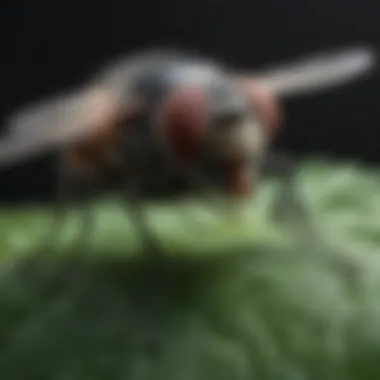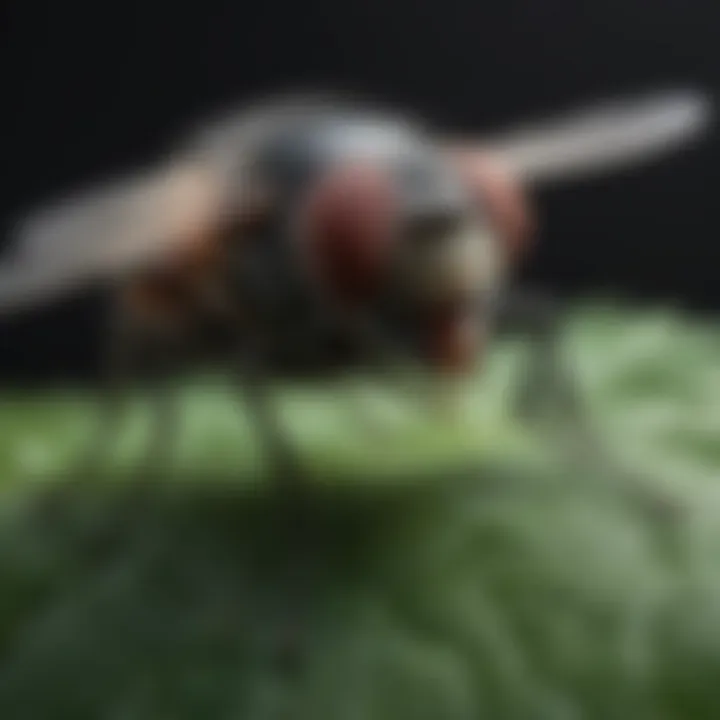Exploring Effective Fly Repellents: Natural and Chemical


Intro
When we think about flies, it’s seldom a pleasant thought. These buzzing nuisances infiltrate our homes, spreading germs and making our cooking area seem unappetizing. However, understanding what makes these pests tick is the first step in dealing with them effectively. This journey into the world of flies doesn’t just arm you with fly repellents; it gives you a deeper understanding of methods to protect and secure your living space.
Understanding the Pest
Flies come in various shapes and sizes, each with distinct characteristics. Identifying them accurately is crucial. The most common culprits in households include house flies, fruit flies, and drain flies.
Identification
- House Fly: Greyish, about 1/8 to 1/4 inch long. Known to breed in decaying matter.
- Fruit Fly: Small, usually tan or light brown, and often found around ripe or rotten fruits.
- Drain Fly: Brown or black, fuzzy appearance, and typically hover around drain areas.
Recognizing these flies can lead you to their breeding sites, enabling more directed pest control strategies.
Life Cycle
Flies reproduce rapidly, which is why they are such a headache. Their life cycle comprises four stages: egg, larva, pupa, and adult. Here’s a brief offering of that cycle:
- Egg: Laid in moist organic matter.
- Larva: Known as maggots, they thrive in the same environment as their eggs.
- Pupa: After feeding, the larvae develop into pupae, where they transition into adult flies.
- Adult: Ready to mate and lay eggs, the cycle begins anew.
Understanding this cycle, especially the fact they can breed in as little as 7 to 10 days, highlights the importance of quick action when flies invade your space.
Pest Prevention Strategies
Adopting effective prevention strategies can keep flies at bay before they even settle in your home.
Environment Modification
Flies thrive in unsanitary environments. Keeping your home clean is essential. Here are some practical tips:
- Regular Cleaning: Ensure all food waste is disposed of properly.
- Seal Entry Points: Close any open windows or doors unless equipped with screens.
- Remove Standing Water: Flies are drawn to moisture.
Physical Barriers
Sometimes, it’s worth it to invest in physical blockades:
- Screens: Install them on windows and doors to keep flies out while allowing airflow.
- Fly Traps: Various traps exist in the market. Choose one that suits your home’s aesthetics and needs.
Control Methods
When prevention fails, you may need to resort to control methods that can significantly reduce the fly population in your home.
Chemical Control
Chemical repellents, while effective, come with their parameters. It’s essential to choose products that are safe for your family and pets. Brands such as Raid and Ortho offer sprays that can eliminate flies quickly. Check their active ingredients and see if they align with your health concerns.
Biological Control
This method taps into nature to combat pests. Consider introducing natural predators like certain species of wasps that target fly larvae. Additionally, essential oils such as lavender and eucalyptus can act as natural repellents.
It’s always best to balance efficiency with safety. Relying solely on chemicals might not be the best long-term solution for your home’s ecosystem.
Intro to Fly Repellents
Flies, those pesky little creatures that seem to buzz around at the most inconvenient times, can be more than just a nuisance. Understanding how to effectively repel them is crucial for maintaining a pleasant and healthy living environment. Fly repellents come into play here, offering homeowners various methods to control these winged intruders, whether they prefer chemical solutions or natural alternatives.
The importance of fly repellents cannot be overstated, especially for families who enjoy spending time outdoors or have small children and pets. This section will lay the groundwork for our discussion, presenting key concepts and benefits related to fly repellents, as well as considerations that every homeowner should keep in mind.
Definition of Fly Repellents
Fly repellents are substances or products designed to deter flies from entering or lingering in an area. These can take various forms, including sprays, traps, and even natural deterrents made from essential oils or household ingredients. At the core, repellents work by masking attractants or emitting odors that flies find unpleasant.
To categorize them, fly repellents can mostly be divided into two camps: chemical repellents, which usually contain synthetic ingredients, and natural repellents, which rely on plant extracts or non-toxic substances. Understanding the differences and uses of these categories is essential for homeowners looking to choose the right type of repellent for their needs.
Significance in Pest Management
In pest management strategies, fly repellents play an integral role. Here are a few reasons why they are significant:
- Health Protection: Flies are known carriers of various diseases. Effective repellents help reduce exposure to pathogens, safeguarding the health of your family and pets.
- Comfort: No one enjoys having flies buzzing around during meals or leisure time. Utilizing repellents can enhance the comfort level of your living or outdoor space.
- Integrated Control Solutions: When combined with good sanitation practices and other pest management approaches, repellents create a more comprehensive solution to fly problems.
"Effective fly repellents not only help in creating a pest-free environment but also play a vital part in promoting health and well-being within our homes."


Flies can reproduce rapidly, making prompt action through repellents crucial. Understanding their behavior, which we’ll dive deeper into later, will facilitate better choices in repellent methods. By ensuring that your approach to repelling flies is informed and effective, you pave the way for a cleaner, more enjoyable living space.
Understanding Fly Behavior
Understanding fly behavior is a cornerstone in exploring effective repellents. Flies are not just pests that annoy; they possess specific traits and habits that influence how we can manage them. Recognizing these aspects can lead to more tailored and effective pest control strategies, making your living space much more comfortable and hygienic.
When we delve into fly behavior, we can better appreciate their biology, attractants, and repellents. Flies like the common housefly or fruit fly each have distinctive habits and lifestyles that can affect how best to repel or trap them. Knowing when and where these flies are most active helps in applying repellents at optimal times and places.
Additionally, understanding how flies are attracted to various stimuli can enable homeowners to reduce these attractants, thereby minimizing the likelihood of fly presence. For example, uncovered food or dirty dishes tend to be magnets for flies. By getting rid of these elements, we can significantly lessen their interest in our spaces.
Biology of Common Flies
Flies belong to the order Diptera and are characterized by their two wings. The most common types include:
- Houseflies: They thrive in a variety of environments, often breeding where organic matter is plentiful.
- Fruit flies: They are attracted to rotten fruit, fermenting food, and liquids like beer or wine.
- Drain flies: These small, fuzzy flies breed in stagnant water.
Flies use their antennae to sense odors and can smell food from a considerable distance. This keen sense plays a vital role in their survival, aiding them in locating sustenance and breeding sites. Interestingly, flies are capable of tasting with their feet, which can be quite beneficial when they land on potential food sources. Their life cycle consists of four stages: egg, larva, pupa, and adult, with each stage presenting different challenges and methods to manage their populations.
Understanding these biological characteristics can lead to more effective fly control methods. For instance, knowing that female flies tend to lay eggs in decaying matter could inform sanitation efforts around the home, as eliminating such breeding grounds would reduce fly populations significantly.
Attractants and Repellents
Attractants play a critical role in fly behavior, guiding them to food, breeding grounds, and sometimes into our homes. Common attractants include:
- Food waste: Any leftover scraps can send flies into a feeding frenzy.
- Overripe fruits: A piece of fruit left on the countertop too long can quickly become an attraction.
- Open trash cans: Uncovered trash is like a welcome mat for flies.
Repellents, on the other hand, are substances that deter flies from approaching. There are both chemical and natural options for this purpose. Understanding what repels flies can turn the tide in pest management. Some common repellents include:
- Chemical sprays: Often containing DEET, these create a barrier around treated areas.
- Essential oils: Oils like peppermint and eucalyptus not only smell pleasant but also drive flies away.
By strategically combining knowledge of attractants and repellents, one can create a well-rounded approach to managing fly populations effectively. The practice may include removing potential attractants while applying repellents in targeted areas to maintain a fly-free environment.
"An ounce of prevention is worth a pound of cure." Keeping your surroundings tidy can drastically reduce fly problems before they begin.
In summary, a thorough understanding of fly behavior—as well as the biology of common types and their attractants—can make a world of difference in effectively repelling these pesky intruders.
Types of Fly Repellents
The battle against flies is as old as time itself. Understanding the urgency of pest control, the section on types of fly repellents taps right into the heart of the matter. Without the right tools in one's arsenal, managing these pesky intruders can feel like fighting an uphill battle. Different repellents serve various needs, leading homeowners and professional exterminators alike to favor specific methods. It's not just about keeping flies at bay; it’s about understanding what distinguishes one approach from another.
Chemical Repellents
Chemical fly repellents are often the go-to solutions for quickly addressing fly infestations. Their efficacy is sometimes unmatched, making them popular among a broad audience. However, there are nuances each user must consider before opting for such methods.
Active Ingredients
The active ingredients in chemical repellents play a vital role in their effectiveness against flies. Common ingredients like DEET, permethrin, and pyrethroids have proven successful for many users. What makes these ingredients widely favored is their ability to disrupt the flies’ nervous systems. Efficacy aside, users ought to be cautious. While these chemicals can swiftly eliminate flies, they come with notable considerations. For instance, high concentrations of DEET can be undesirable for families with young children due to potential skin irritations. Thus, the balance of effectiveness and safety is paramount when selecting a product containing these active ingredients.
Mechanism of Action
Understanding how chemical repellents work helps frame one's choices in pest control. These products usually create a barrier that interferes with a fly's ability to detect food sources or breeding grounds. The key characteristic here is that they often combine multiple methods to confuse or repel these pests effectively. Their appeal largely lies in immediate results. However, users should be aware of the lingering residues these substances can leave behind, which can affect the local environment or even contribute to resistance among fly populations over time. Therefore, it's wise to consider the long-term implications alongside the quick fixes.
Health Risks
While chemical repellents offer substantial benefits, they are not without health risks. Chronic exposure to certain ingredients can lead to respiratory problems, allergic reactions, or skin sensitivities for some individuals. Those with pre-existing underlying conditions should consult their physician before employing such methods. A prominent concern includes the impact these chemicals have on beneficial insects and the broader ecosystem. Despite their rapid results, users must weigh the health implications significantly; after all, the goal is not just to eliminate flies but to do so in a manner that does not compromise human health.
Natural Repellents
The increasing awareness regarding sustainability has propelled natural repellents into the spotlight. Many homeowners today prefer going the eco-friendly route, aligning their pest control methods with a holistic lifestyle.
Plant-Based Solutions
Plant-based solutions emanate from nature, utilizing botanical extracts known for their insect-repelling properties. Ingredients like citronella, eucalyptus, and lavender are not just pleasant to the senses; they actively deter flies. These natural products resonate with concerned consumers seeking non-toxic alternatives. One key characteristic is their pleasing aroma, which not only helps keep flies away but also elevates the ambiance of living spaces. Nonetheless, their effectiveness may wane quicker than their chemical counterparts, requiring more frequent reapplication.
Essential Oils
Essential oils have saturated the market as a trendy alternative to synthetic repellents. Oils such as peppermint, tea tree, and lemongrass boast strong scent profiles that deter flies. Users are drawn to them for their multifaceted applications, from aromatic therapies to household cleaning. The versatility of these oils is a unique feature, allowing homeowners to use one product for various needs, such as repelling flies and refreshing spaces. However, dilution is critical; undiluted oils can irritate the skin, and their effectiveness can vary based on environmental conditions.
Homemade Remedies
Homemade remedies have charmed many DIY enthusiasts, appealing to those not keen on store-bought solutions. Simple concoctions using vinegar, dish soap, and essential oils can create potent barriers against flies. The key characteristic here is their customization—users can tweak recipes to fit their specific needs. What's more, these remedies are often budget-friendly, making them attractive for cost-conscious households. However, DIY solutions may lack the durability of commercial products, sometimes necessitating more frequent applications to maintain their efficacy against persistent fly populations.
Ultimately, understanding the spectrum of fly repellents empowers users to make informed decisions tailored to their unique situations. By recognizing the strengths and weaknesses of each approach, householders can enhance their pest management strategy effectively.


Efficacy of Fly Repellents
The efficacy of fly repellents plays a crucial role in not just controlling pest populations, but also in safeguarding health and well-being. Different environments, varying types of flies, and the essence of repelling them all require a nuanced understanding to reach optimal results. Homeowners and pest management professionals alike must comprehend the critical elements surrounding the effectiveness of repellents to make educated choices that align with their specific needs.
Comparative Analysis of Methods
When assessing the effectiveness of various fly repellent methods, it’s essential to evaluate them based on their ingredients, application techniques, and the contexts in which they excel. A stark contrast exists between chemical and natural repellents.
- Chemical Repellents: These often contain synthetic compounds that can provide immediate results. The active ingredients, such as DEET or permethrin, are known for their strong offensive against multiple pest species. However, the downside to these products is that they may pose health risks and environmental concerns, particularly if misused.
- Natural Alternatives: On the flip side, natural repellents rely on substances derived from plants and essential oils—these have gained popularity due to their perceived safety. Ingredients like citronella and eucalyptus oil may not boast the same immediate results as chemicals, but they help create a less hospitable environment for flies.
A thorough comparative analysis should consider parameters like application ease and duration of effectiveness alongside efficacy.
Duration of Effectiveness
A fly repellent that works like a charm but lasts mere minutes is of little value to homeowners needing long-term solutions. Understanding how long different repellents last following application is vital. Chemical formulations typically exhibit prolonged efficacy, often maintaining protection for several hours. Conversely, natural solutions may require more frequent reapplication, depending on the specific formula and environmental factors.
- Chemical repellents can usually last between 4 to 8 hours.
- Natural repellents, while safer, often last around 2 to 4 hours.
Such differences underscore the need for strategic planning when approaching pest management. Knowing how long each repellent can keep flies at bay helps guide when and how often to apply products, thus ensuring a proactive approach to fly control.
User Experience and Testimonials
User experiences can offer invaluable insights into the practical effectiveness of fly repellents. While scientific studies provide a wealth of data, real-life testimonials can shed light on how products perform under everyday conditions.
Many homeowners report that chemical repellents deliver fast results but sometimes lead to concerns regarding safety, especially in homes with children or pets. In contrast, users of natural remedies often highlight the pleasant scent and peace of mind they feel when using less harmful products, although some mention a need to reapply more frequently.
"I tried using a product with eucalyptus oil—while it smelled lovely, it didn’t keep the little buggers away as long as I hoped! Guess I’m back to the heavy artillery next barbecue!"
Such feedback points to the importance of aligning personal values with effectiveness. Thus, before selecting a fly repellent, users should consider not only the efficacy of the product but also how it fits into their lifestyle.
In sum, understanding the efficacy of fly repellents involves more than just identifying what works best. It requires a multifaceted examination of comparative methods, the duration of their effects, and insights gained from user experiences. This comprehensive approach equips homeowners with the necessary knowledge to make informed decisions when exploring options for pest management.
Application Techniques
The effectiveness of fly repellents doesn't solely hinge on the formulation but significantly on how they are applied. The application techniques used can vary broadly, influencing everything from immediate efficacy to the longevity of protection. Understanding this aspect is essential for anyone looking to effectively manage fly populations around their homes.
First and foremost, application techniques can make or break a repellent's success. Without proper application, even the best products may falter. Some techniques utilize sprays for direct treatment, while others incorporate traps and devices. This section will examine these varied methods, along with Integrated Pest Management (IPM) strategies that provide a holistic approach to pest control.
Spray Methods
Using sprays is among the most common techniques to repel flies. There are a few key benefits to opting for spray methods. For starters, they offer immediate results. The application is straightforward; simply spray the desired area, and it’s tactical against flies lurking nearby.
However, it’s vital to consider the following aspects:
- Coverage: Ensuring full coverage is crucial to maximizing efficiency. Flies are often adept at finding overlooked spots.
- Timing: Applying sprays at peak activity times can significantly boost effectiveness.
- Formulation: It’s also worth scrutinizing the repellent's formulation, as specific chemicals may interact differently with environmental factors such as humidity and temperature.
Moreover, it’s advisable to read the label thoroughly to determine the recommended distance and specific areas to cover when spraying. Millions of bottles may scream "fly solution," but choosing the right one depends on understanding your environment and the product itself.
Traps and Devices
Another effective application technique involves traps and devices designed to capture or deter flies. These tools can vary from simple DIY contraptions to elaborate systems incorporating the latest technology. Their significance cannot be overstated.
- Types: These come in diverse forms, such as sticky traps, bait traps, and electric devices that lure in flies. Each type serves a unique purpose based on the environment and infestation level.
- Placement: Proper placement of these traps is crucial. Common areas like doorways, near waste containers, and outdoor spaces should be prioritized for trapping. Proximity to attractants will yield better results.
- Maintenance: Regularly checking and maintaining these devices ensures they remain effective over time. A neglected trap may become a breeding ground for flies rather than a deterrent.
Remember: Lack of upkeep can turn traps into a nuisance instead of a solution, so make it part of your routine to empty and replace them as needed.
Integrated Pest Management Strategies
Integrated Pest Management (IPM) strategies combine various techniques to provide a comprehensive approach to managing fly populations. Rather than relying solely on sprays or traps, IPM emphasizes a multifaceted perspective that incorporates structural, biological, and chemical methods.
- Preventive Measures: This strategy includes keeping areas clean and free from food scraps that can attract flies. Small changes in routine can greatly reduce the likelihood of infestations.
- Monitoring: Regularly observing fly activity can help in determining the most effective action plan. Understanding when and where flies are most active allows for targeted interventions.
- Collaboration of Methods: By integrating different application techniques, a homeowner can create a more robust defense. For example, combining sprays for immediate action while employing traps for ongoing control can yield impressive results.
In summary, choosing the right application techniques is just as important as selecting the most effective repellent. Each method—be it spray, traps, or IPM—offers unique advantages. Understanding how to deploy these techniques successfully will arm you with the knowledge and tools necessary to manage fly populations effectively.
Safety Considerations
When dealing with fly repellents, one cannot overlook the pivotal role of safety. It’s not just about keeping the pests at bay; it's about ensuring that the chosen solutions do not pose other risks to our health or the environment. The unfortunate reality is that some repellents, particularly those that are chemical in nature, can carry potential hazards that must be considered diligently. Understanding these safety considerations can empower homeowners to make informed choices, protecting both their families and the surroundings.
Human Health Implications
The health implications of using fly repellents can run the gamut from mild irritations to more serious health concerns. When applying chemical-based repellents, one must be especially vigilant as these products may contain ingredients that can cause allergic reactions or other adverse effects. Below are some key points to consider regarding human health:
- Skin Absorption: Some chemicals can be absorbed through the skin, potentially leading to rashes or systemic effects.
- Respiratory Issues: Aerosol sprays can irritate the lungs, especially for those with pre-existing conditions like asthma or chronic obstructive pulmonary disease (COPD).
- Children and Pets: It's essential to think about how attractants affect young children and pets, as they often have a less developed immunity and can be more sensitive to chemical exposure.


In light of these dangers, it becomes vital to read labels closely and follow the instructions provided by the manufacturers. Moreover, opting for safer alternatives, such as natural repellents or using traps, can mitigate these health risks effectively.
Environmental Impact
The link between fly repellents and their environmental footprint cannot be understated. While trying to eliminate flies, one might inadvertently harm non-target species or contaminate essential ecosystems. Consider the following:
- Chemical Runoff: When used outdoors, chemical repellents can wash into local waterways, threatening aquatic life.
- Biodiversity Concerns: Broad-spectrum chemicals might not only kill flies but also beneficial insects such as bees, butterflies, and other pollinators.
- Air Quality Deterioration: Many chemical repellents release volatile organic compounds (VOCs), contributing to air pollution—something all urban dwellers should think twice about.
"Taking steps toward environmentally friendly pest management not only safeguards nature but ensures healthier living conditions for our families."
By being mindful of both human health implications and environmental consequences, homeowners can adopt a more holistic approach to pest management. Selecting repellents that strike a balance between effectiveness and safety means fostering a healthier home while being responsible stewards of our planet. It's about a smart choice that keeps pests at bay without compromising the well-being of those we love.
Regulatory Framework
When navigating the world of fly repellents, understanding the regulatory framework is crucial. This framework governs how these products are developed, marketed, and used in various settings. Knowing this ensures users, particularly homeowners and professionals, are making informed choices regarding effectiveness and safety.
One of the primary elements is the regulation of chemical repellents. Government bodies like the Environmental Protection Agency (EPA) develop standards that ensure these products do not pose undue risk to human health or the environment. This regulatory oversight helps to foster public confidence in using fly repellents without fearing harmful side effects.
"Effective regulation assures consumers that the repellents they utilize are both safe and efficacious."
Another key aspect falls under labeling and usage guidelines. When purchasing any fly repellent, it’s important to pay attention to how the product is labeled. This section informs not only about the active ingredients but also outlines usage instructions, safety precautions, and how to properly dispose of leftover product. Adhering to these guidelines is a fundamental part of responsible pest management.
Government Regulations on Chemicals
Chemical fly repellents are subjected to stringent regulations designed to guarantee their safety and effectiveness. In the United States, for instance, the EPA evaluates new chemical substances to determine whether they can be marketed without posing risks to health. This evaluation includes:
- Toxicological Testing: Looking into any potential health risks associated with exposure.
- Environmental Assessments: Ensuring that these chemicals will not adversely affect wildlife or the ecology.
Moreover, brands must submit registration documents, along with required scientific data, before they can sell their products. This could prevent fly repellents that are ineffective or hazardous from reaching the market, ultimately benefiting users.
Labeling and Usage Guidelines
Labeling is more than just a requirement; it’s a user’s roadmap to safe and effective use of fly repellents. Well-crafted labels provide:
- Active Ingredient Information: Clear indication of what substances are in the repellents, helping consumers make knowledgeable choices based on their needs.
- Recommended Application Methods: Details on how to properly apply the product for maximum efficacy, whether through sprays, devices, or topical applications.
- Safety Warnings: Potential risks associated with the product's use, including allergic reactions or environmental hazards.
- Disposal Instructions: Guidelines on how to dispose of left-over products safely, minimizing any environmental impact.
Users must read and follow these guidelines carefully. Not doing so can lead to ineffective pest control and unnecessary health risks.
This regulatory framework not only protects consumers but also promotes responsible nighttime practices among companies, encouraging the development and use of safer fly repellent options.
Future Directions in Fly Control
As we look towards the future of pest management, the evolution of fly control methods becomes vital. With increasing concerns regarding human health and environmental impacts, it’s clear that innovation in this field is paramount. The importance of exploring future directions in fly control lies not only in the effectiveness of new strategies but also in their sustainability and safety.
Innovations in Repellent Technology
The realm of fly repellents is witnessing groundbreaking advancements. As consumer awareness grows regarding the potential harmful effects of conventional repellents, researchers are eager to provide alternatives that are both effective and safe. Memory foam, for instance, is being looked at as a potential medium for delivering essential oils - the foam can trap the scent, releasing it gradually to naturally deter flies.
Moreover, wearable technology is on the rise. Imagine a lightweight device like a bracelet that emits frequencies or scents known to repel flies, allowing users to go about their day without worry. Such innovations can provide a hassle-free experience and can be especially beneficial for families with children or pets.
"Consumers are increasingly demanding eco-friendly and innovative solutions to tackle pests, which drives the industry to rethink traditional approaches."
Additionally, the use of smart technology in traps that utilize UV light or heat has shown promise. These devices attract flies and then use safe electrocutors to eliminate them all while being energy efficient.
Role of Biotechnology
Biotechnology introduces an exciting frontier in fly control. Research into genetically modified organisms (GMOs) offers the potential for creating attractants that can either lure flies away from homes or eliminate them at the source. For instance, engineered bacteria that disrupt the reproductive cycle of flies could lead to a significant decrease in their populations without disrupting the surrounding ecosystem.
Another captivating avenue is the development of biopesticides derived from naturally occurring substances. These biopesticides often have lower toxicity profiles and can be more effective in targeting specific pests, reducing side effects. For example, utilizing certain plant extracts known to affect fly pheromone production could lead to a new targeted method of keeping them at bay.
Furthermore, ongoing scientific efforts to understand the genetic makeup of common flies can lead to breakthroughs in biologically modifying these pests to make them less harmful or less likely to reproduce. This kind of innovation not only presents direct benefits but can also improve ecological balance.
Ending
Summary of Findings
The investigation into fly repellents reveals a multifaceted landscape. Here are a few notable points:
- Variety of Repellents: Both chemical and natural repellents have unique advantages. Chemical repellents often offer prolonged effectiveness but can pose risks to health and the environment. On the other hand, natural alternatives, such as essential oils and homemade solutions, provide safer options but may require more frequent application.
- Fly Behavior: Understanding fly biology and their attractants allows for more targeted repellent usage, ensuring that homeowners can select methods that align with the specific types of flies they face in their environment.
- Applicability: The efficacy of various repellents may vary depending on factors like application technique, concentration, and environmental conditions.
Adapting a strategic approach tailored to individual circumstances enhances the effectiveness of fly control efforts.
Recommendations for Readers
For homeowners and housewives looking to tackle fly issues, consider these actionable insights:
- Assess the Environment: Identify areas where flies are prevalent, and determine the species involved. This understanding can guide your choice of repellent.
- Choose Wisely: Consider both chemical and natural repellents based on your comfort level with each. Research specific products that have been praised for efficacy in user testimonials.
- Mixed Method Approach: Sometimes, a combination of methods works best—for instance, using traps alongside repellents can create a more comprehensive strategy.
- Stay Informed: Regularly review safety data and studies about modern repellents. By staying informed, you can adapt your strategies according to the latest findings in pest management.
- Contribute to Safe Practices: Be mindful of your surroundings and environmental impact. Opt for eco-friendly repellents whenever feasible to help minimize adverse effects on wildlife and ecosystems.
These recommendations can empower readers to make educated decisions, fostering a safe home environment while effectively managing fly populations.







